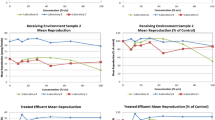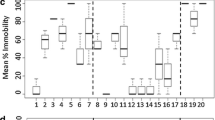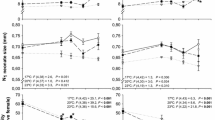Abstract
Daphnia magna continues to be the most widely used organism in aquatic hazard assessment, for reasons relating to its ease of culture in the laboratory and the ability to maintain clonal lines of female individuals. However, despite its widespread use for estimation of the acute and chronic toxicity of new and existing substances, doubts still remain concerning its use as a representative of aquatic fauna, with interlaboratory variation in response being recognised as a serious problem. Experimental studies which have attempted to identify and quantify the components of interlaboratory variation in response (Baird et al., 1989, 1991; Soares et al., 1992) have indicated that both the genotype of the clone used in tests and the environmental conditions prior to and during the tests play significant roles in determining this variability. Moreover, it is clear that the relative response of clones does not remain consistent across the substances tested, not even for similar classes of substance, indicating that genotype-environment interactions also play an important role in governing response.
Access this chapter
Tax calculation will be finalised at checkout
Purchases are for personal use only
Preview
Unable to display preview. Download preview PDF.
Similar content being viewed by others
References
Allen Y, Baird DJ and Calow P (1995) A mechanistic model of contaminant-induced feeding inhibition in Daphnia magna. Environmental Toxicology & Chemistry 14 1625–1630.
Baird DJ, Barber I, Bradley MC, Calow P, Soares AMVM (1989) The Daphnia bioassay: a critique. Hydrobiologia 188 /189: 403–406
Baird DJ, Barber I and Calow P (1990) Clonal variation in general responses of Daphnia magna Straus to toxic stress. I. Chronic life-history effects. Functional Ecology 4: 399–407
Baird DJ, Barber I, Bradley MC, Soares AMVM, Calow P (1991) A comparative study of genotype sensitivity to acute toxic stress using clones of Daphnia magna Straus. Ecotoxicology and Environmental Safety 21: 257–265
Baird DJ, Barber I, Bradley MC, Soares AMVM, Calow P (1991) A comparative study of genotype sensitivity to acute toxic stress using clones of Daphnia magna Straus. Ecotoxicology and Environmental Safety 21: 257–265
Bates K, Hedgecott S, Grimwood M, Sims I, Fawell JK (1996) Ecotoxicological Risk Assessment Manual for Chemicals in the Aquatic Environment. Scottish and Northern Ireland Forum for Environmental Research Report SR 3846 /1
Calow P (1992) The three Rs of ecotoxicology. Functional Ecology 6: 617–619
Enserink L, Luttmer W and Maas-Diepeveen H (1990) Reproductive strategy of Daphnia affects the sensitivity of its progeny in acute toxicity tests. Aquatic Toxicology 17: 15–25
Finney DJ (1971) Probit Analysis. 3rd Edition. Cambridge University Press, Cambridge, UK.
OECD (1997) Guideline for Testing of Chemicals no. 202. Daphnia sp. Acute immobilisation test and reproduction test. Organization for Economic Co-operation and Development, Paris.
Soares AMVM, Baird DJ, Calow P (1992) Interclonal variation in the performance of Daphnia magna Straus in chronic bioassays. Environmental Toxicology and Chemistry 11: 1477–1483
Author information
Authors and Affiliations
Editor information
Editors and Affiliations
Rights and permissions
Copyright information
© 1998 Springer-Verlag Berlin Heidelberg
About this paper
Cite this paper
Baird, D.J., Barata, C. (1998). Variability in the Response of Daphnia Clones to Toxic Substances: Are Safety Margins Being Compromised?. In: Seiler, J.P., Autrup, J.L., Autrup, H. (eds) Diversification in Toxicology — Man and Environment. Archives of Toxicology, vol 20. Springer, Berlin, Heidelberg. https://doi.org/10.1007/978-3-642-46856-8_35
Download citation
DOI: https://doi.org/10.1007/978-3-642-46856-8_35
Publisher Name: Springer, Berlin, Heidelberg
Print ISBN: 978-3-642-46858-2
Online ISBN: 978-3-642-46856-8
eBook Packages: Springer Book Archive




